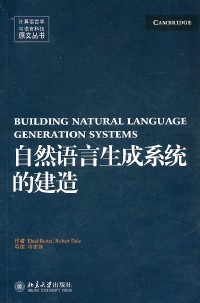
Building natural language generation systems = 自然语言生成系统的建造 /
副标题:无
作 者:Ehud Reiter, Robert Dale ; 导读, 冯志伟.
分类号:
ISBN:9787301171547
微信扫一扫,移动浏览光盘
简介
本书介绍怎样来建造一个自然语言生成系统。自然语言生成系统是一个计算机软件系统,它使用人工智能和计算语言学的方法和技术,自动地生成可理解的自然语言文本,这样的文本可以是独立的,也可以是多媒体文档的一个组成部分。自然语言生成系统要从某种非语言表达出发,以这种非语言表达作为信息的输入,使用语言知识和用应用系统的领域知识,自动地产生出文档、报告、说明书、帮助信息以及其他类型的文本。
目录
导读
Preface
List of Figures
1Introduction
1.1 The Research Perspective
1.1.1 Differences between NL Generation and NL Understanding
1.1.2 Sharing Knowledge between Generation and Understanding
1.2 The Applications Perspective
1.2.1 Computer as Authoring Aid
1.2.2 Computer as Author
1.2.3 Uses of NLG Technology
1.3 Some Example NLG Systems
1.3.1 WEATHERREPORTER
1.3.2 FOG
1.3.3 IDAS
1. 3.4 MODELEXPLAINER
1.3.5 PEBA
1.3.6 STOP
1. 4 A Short History of NLG
1.5 The Structure of This Book
1.6 Further Reading
2 National Language Generation in Practice
2.1 Introduction
2.2 When Are NLG Techniques Appropriate?
2.2.1 Text versus Graphics
2.2.2 Natural Language Generation versus Mail Merge
2.2.3 Natural Language Generation versus Human Authoring
2.3 Using a Corpus to Determine User Requirements
2.3.1 Assembling an Initial Corpus of Output Texts
2.3.2 Analysing the Information Content of Corpus Texts
2.3.3 Creating a Target Text Corpus
2.4 Evaluating NLG Systems
2.5 Fielding NLG Systems
2.6 Further Reading
3The Architecture of a Natural Language Generation System
3.1 Introduction
3.2 The Inputs and Outputs of Natural Language Generation
3.2.1 Language as Goal-Driven Communication
3.2.2 The Inputs to Natural Language Generation
3.2.3 The Output of Natural Language Generation
3.3 An Informal Characterisation of the Architecture
3.3.1 An Overview of the Architecture
3.3.2 Content Determination
3.3.3 Document Structuring
3.3.4 Lexicalisation
3.3.5 Referring Expression Generation
3.3.6 Aggregation
3.3.7 Linguistic Realisation
3.3.8 Structure Realisation
3.4 The Architecture and Its Representations
3.4.1 Broad Structure and Terminology
3.4.2 Messages
3.4.3 The Document Planner
3.4.4 Document Plans
3.4.5 Microplanning
3.4.6 Text Specifications
3.4.7 Phrase Specifications
3.4.8 Surface Realisation
3.5 0ther Architectures
3.5.1 Different Representations and Modularisations
3.5.2 Different Architectures: Integrated Systems
3.6 Further Reading and Message Definition
4 Document Planning
4.1 Introduction
4.1.1 What Document Planning Is About
4.1.2 The Inputs and Outputs of Document Planning
4. 1.3 A WEATHERREPORTER Example
4.2 Representing Information in the Domain
4.2.1 What's in a Domain Model?
4.2.2 Domain Modelling for WEATHERREPORTER
4.2.3 Implementing Domain Models
4.2.4 Defining Messages
4.2.5 Determining the Degree of Abstraction in Messages
4.2.6 A Methodology for Domain Modelling
4.3 Content Determination
4.3.1 Aspects of Content Determination
4.3.2 Deriving Content Determination Rules
4.3.3 Implementing Content Determination
4.4 Document Structuring
4.4. 1 Discourse Relations
4.4.2 Implementation. Schemas
4.4.3 Implementation: Bottom-up Techniques
4.4.4 A Comparison of Approaches
4.4.5 Knowledge Acquisition
4.5 Document Planner Architecture
4.6 Further Reading
5Microplanning
5.1 Introduction
5.1.1 Why Do We Need Microplanning?
5.1.2 What's Involved in Microplanning?
5. 1.3 The Inputs and Outputs of Microplanning ...
5.1.4 The Architecture of a Microplanner
5.2 Lexicalisation
5.2. 1 Simple Lexicalisation
5.2.2 Simple Lexical Choice
5.2.3 Contextual and Pragmatic Influences
on Lexical Choice
5.2.4 Expressing Discourse Relations
5.2.5 Fine-Grained Lexicalisation
5.3 Aggregation
5.3.1 Mechanisms for Sentence Formation
5.3.2 Choosing between Possible Aggregations ...
6 Surface Realisation
7 Beyond Text Generation
Appendix:NLG Systems Mentioned in This Book
References
Index
Preface
List of Figures
1Introduction
1.1 The Research Perspective
1.1.1 Differences between NL Generation and NL Understanding
1.1.2 Sharing Knowledge between Generation and Understanding
1.2 The Applications Perspective
1.2.1 Computer as Authoring Aid
1.2.2 Computer as Author
1.2.3 Uses of NLG Technology
1.3 Some Example NLG Systems
1.3.1 WEATHERREPORTER
1.3.2 FOG
1.3.3 IDAS
1. 3.4 MODELEXPLAINER
1.3.5 PEBA
1.3.6 STOP
1. 4 A Short History of NLG
1.5 The Structure of This Book
1.6 Further Reading
2 National Language Generation in Practice
2.1 Introduction
2.2 When Are NLG Techniques Appropriate?
2.2.1 Text versus Graphics
2.2.2 Natural Language Generation versus Mail Merge
2.2.3 Natural Language Generation versus Human Authoring
2.3 Using a Corpus to Determine User Requirements
2.3.1 Assembling an Initial Corpus of Output Texts
2.3.2 Analysing the Information Content of Corpus Texts
2.3.3 Creating a Target Text Corpus
2.4 Evaluating NLG Systems
2.5 Fielding NLG Systems
2.6 Further Reading
3The Architecture of a Natural Language Generation System
3.1 Introduction
3.2 The Inputs and Outputs of Natural Language Generation
3.2.1 Language as Goal-Driven Communication
3.2.2 The Inputs to Natural Language Generation
3.2.3 The Output of Natural Language Generation
3.3 An Informal Characterisation of the Architecture
3.3.1 An Overview of the Architecture
3.3.2 Content Determination
3.3.3 Document Structuring
3.3.4 Lexicalisation
3.3.5 Referring Expression Generation
3.3.6 Aggregation
3.3.7 Linguistic Realisation
3.3.8 Structure Realisation
3.4 The Architecture and Its Representations
3.4.1 Broad Structure and Terminology
3.4.2 Messages
3.4.3 The Document Planner
3.4.4 Document Plans
3.4.5 Microplanning
3.4.6 Text Specifications
3.4.7 Phrase Specifications
3.4.8 Surface Realisation
3.5 0ther Architectures
3.5.1 Different Representations and Modularisations
3.5.2 Different Architectures: Integrated Systems
3.6 Further Reading and Message Definition
4 Document Planning
4.1 Introduction
4.1.1 What Document Planning Is About
4.1.2 The Inputs and Outputs of Document Planning
4. 1.3 A WEATHERREPORTER Example
4.2 Representing Information in the Domain
4.2.1 What's in a Domain Model?
4.2.2 Domain Modelling for WEATHERREPORTER
4.2.3 Implementing Domain Models
4.2.4 Defining Messages
4.2.5 Determining the Degree of Abstraction in Messages
4.2.6 A Methodology for Domain Modelling
4.3 Content Determination
4.3.1 Aspects of Content Determination
4.3.2 Deriving Content Determination Rules
4.3.3 Implementing Content Determination
4.4 Document Structuring
4.4. 1 Discourse Relations
4.4.2 Implementation. Schemas
4.4.3 Implementation: Bottom-up Techniques
4.4.4 A Comparison of Approaches
4.4.5 Knowledge Acquisition
4.5 Document Planner Architecture
4.6 Further Reading
5Microplanning
5.1 Introduction
5.1.1 Why Do We Need Microplanning?
5.1.2 What's Involved in Microplanning?
5. 1.3 The Inputs and Outputs of Microplanning ...
5.1.4 The Architecture of a Microplanner
5.2 Lexicalisation
5.2. 1 Simple Lexicalisation
5.2.2 Simple Lexical Choice
5.2.3 Contextual and Pragmatic Influences
on Lexical Choice
5.2.4 Expressing Discourse Relations
5.2.5 Fine-Grained Lexicalisation
5.3 Aggregation
5.3.1 Mechanisms for Sentence Formation
5.3.2 Choosing between Possible Aggregations ...
6 Surface Realisation
7 Beyond Text Generation
Appendix:NLG Systems Mentioned in This Book
References
Index
Building natural language generation systems = 自然语言生成系统的建造 /
- 名称
- 类型
- 大小
光盘服务联系方式: 020-38250260 客服QQ:4006604884
云图客服:
用户发送的提问,这种方式就需要有位在线客服来回答用户的问题,这种 就属于对话式的,问题是这种提问是否需要用户登录才能提问
Video Player
×
Audio Player
×
pdf Player
×


